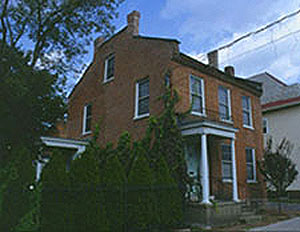


226 Pearl Street
Former Name: The J.V. Randall House
Current Name: The Seagle Dwelling
Date: ca. 1820 (possibly 1853)
The history of 226 Pearl Street, formerly known as the J.V. Randall House, is a bit of a mystery. It appears on the 1853 Sanborn map and according to the Historic Sites and Structures survey it was built circa 1820. However, it doesn't appear on the 1830 map and very little is known about the original owner or the history of the home prior to 1853. The house, a three-by-three bay, two-and-a-half story Federal style brick structure with paired end chimneys has a distinctly urban character and is one of the few surviving examples of a traditional early 19th century rowhouse in Burlington. (1)
J. V. Randall is thought to be the original builder and owner of the house, however, little is known about him or his role in the city of Burlington. In 1860, Alfred K. Ballard, a prominent potter in Burlington, purchased the property. He and his family resided at this estate until his death in 1874, when his wife took over. The property then came under the ownership of Gilbert Dow, the Assistant City Clerk of Burlington in 1875. Dow and his family remained at the home until approximately 1920. It was at this time that Mrs. Dow, now a widow, sold the property. Ownership changed hands several times over the next few years, and was used as both a residence and business office. The house lay vacant from 1925 until 1928 when it was purchased by Thomas Greene. Greene maintained ownership of the property until the early 1940s. Owen Humphrey, an osteopath, gained ownership in 1941 and used the building as both a residence and an office until 1971. At that time, Finley Seagle became the owner of the house. It is still used as a residence today. (2)
Although the house maintains many of its original features, several additions have been made. A narrow, two-story clapboard addition on the east facade was added in the late 19th century. At the rear of the house, a three-sided bay window and two three-sided oriel windows are also late 19th century additions.
The controversy surrounding the date affixed to the home comes from the use of molded brick at the cornice line. This type of masonry was not seen until 1850, which casts doubt on the earlier date of 1820. However, it is possible that the cornice line and roof had undergone repairs or had been replaced, as little is known about the owner prior to 1860. Research of the physical evidence inside this building could help resolve its early history.
233 Pearl Street - The T.R. Fletcher House
Sources:
(1) State of Vermont Division of Historic Preservation: Historic Sites and Structures Survey, 1977.
(2) Burlington City Directories, 1866-1975.